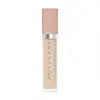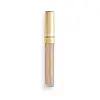What's inside
What's inside
 Key Ingredients
Key Ingredients

 Benefits
Benefits

 Concerns
Concerns

 Ingredients Side-by-side
Ingredients Side-by-side

Water
Skin ConditioningCyclopentasiloxane
EmollientIsododecane
EmollientHdi/Trimethylol Hexyllactone Crosspolymer
Polyglyceryl-4 Isostearate
EmulsifyingPropanediol
SolventCetyl PEG/PPG-10/1 Dimethicone
EmulsifyingHexyl Laurate
EmollientAluminum Starch Octenylsuccinate
AbsorbentPropylene Glycol
HumectantDimethicone
EmollientLauryl PEG/PPG-18/18 Methicone
Skin ConditioningMagnesium Sulfate
Disteardimonium Hectorite
StabilisingTheobroma Cacao Extract
Skin ConditioningGlycine Soja Oil
EmollientOryza Sativa Extract
AbsorbentOryza Sativa Germ Extract
EmollientTocopherol
AntioxidantCaprylic/Capric Triglyceride
MaskingDimethicone/Vinyl Dimethicone Crosspolymer
Skin ConditioningPropylene Carbonate
SolventTriethoxycaprylylsilane
Silica
AbrasiveAlumina
AbrasiveEthylhexylglycerin
Skin ConditioningPolyglyceryl-3 Diisostearate
EmulsifyingIsostearyl Alcohol
EmollientPhenoxyethanol
PreservativeParfum
MaskingLinalool
PerfumingCitronellol
PerfumingLimonene
PerfumingCI 77891
Cosmetic ColorantCI 77163
Cosmetic ColorantCI 77492
Cosmetic ColorantCI 77499
Cosmetic ColorantCI 77491
Cosmetic ColorantWater, Cyclopentasiloxane, Isododecane, Hdi/Trimethylol Hexyllactone Crosspolymer, Polyglyceryl-4 Isostearate, Propanediol, Cetyl PEG/PPG-10/1 Dimethicone, Hexyl Laurate, Aluminum Starch Octenylsuccinate, Propylene Glycol, Dimethicone, Lauryl PEG/PPG-18/18 Methicone, Magnesium Sulfate, Disteardimonium Hectorite, Theobroma Cacao Extract, Glycine Soja Oil, Oryza Sativa Extract, Oryza Sativa Germ Extract, Tocopherol, Caprylic/Capric Triglyceride, Dimethicone/Vinyl Dimethicone Crosspolymer, Propylene Carbonate, Triethoxycaprylylsilane, Silica, Alumina, Ethylhexylglycerin, Polyglyceryl-3 Diisostearate, Isostearyl Alcohol, Phenoxyethanol, Parfum, Linalool, Citronellol, Limonene, CI 77891, CI 77163, CI 77492, CI 77499, CI 77491
Water
Skin ConditioningDimethicone
EmollientPhenyl Trimethicone
Skin ConditioningIsododecane
EmollientHydrogenated Polycyclopentadiene
Talc
AbrasiveButylene Glycol
HumectantPolyglyceryl-4 Isostearate
EmulsifyingCetyl PEG/PPG-10/1 Dimethicone
EmulsifyingHexyl Laurate
EmollientHydrogenated Castor Oil
EmollientHydrogenated Microcrystalline Cera
Silica
AbrasivePhenoxyethanol
PreservativeMica
Cosmetic ColorantTriethoxycaprylylsilane
Aluminum Hydroxide
EmollientBenzoic Acid
MaskingNiacinamide
SmoothingDisodium EDTA
Dehydroacetic Acid
PreservativePropylene Glycol
HumectantTrimethoxycaprylylsilane
SmoothingEthylhexylglycerin
Skin ConditioningBHT
AntioxidantAscorbic Acid
AntioxidantTin Oxide
AbrasiveSodium Hyaluronate
HumectantAcacia Seyal Gum Extract
HumectantPotassium Sorbate
PreservativeIsopropyl Alcohol
SolventCI 77891
Cosmetic ColorantCI 77492
Cosmetic ColorantCI 77491
Cosmetic ColorantCI 77499
Cosmetic ColorantWater, Dimethicone, Phenyl Trimethicone, Isododecane, Hydrogenated Polycyclopentadiene, Talc, Butylene Glycol, Polyglyceryl-4 Isostearate, Cetyl PEG/PPG-10/1 Dimethicone, Hexyl Laurate, Hydrogenated Castor Oil, Hydrogenated Microcrystalline Cera, Silica, Phenoxyethanol, Mica, Triethoxycaprylylsilane, Aluminum Hydroxide, Benzoic Acid, Niacinamide, Disodium EDTA, Dehydroacetic Acid, Propylene Glycol, Trimethoxycaprylylsilane, Ethylhexylglycerin, BHT, Ascorbic Acid, Tin Oxide, Sodium Hyaluronate, Acacia Seyal Gum Extract, Potassium Sorbate, Isopropyl Alcohol, CI 77891, CI 77492, CI 77491, CI 77499
Ingredients Explained
These ingredients are found in both products.
Ingredients higher up in an ingredient list are typically present in a larger amount.
This ingredient is a high molecular weight silicone. It has emulsifying and skin conditioning properties.
Ci 77491 is also hydrated iron III oxide. It's sole purpose is to give a red/pink hue to products.
Iron III oxides are classified as inorganic chemicals for coloring.
Synthetically created Ci 77491 is considered safer than those naturally found. This is because the synthetically created version may contain less impurities. Iron oxides are generally non-toxic and non-allergenic.
Learn more about CI 77491Ci 77492 is also hydrated iron III oxide. It's sole purpose is to give a yellow hue to products.
Iron III oxides are classified as inorganic chemicals for coloring.
Synthetically created Ci 77492 is considered safer than those naturally found. This is because the synthetically created version may contain less impurities. Iron oxides are generally non-toxic and non-allergenic.
Learn more about CI 77492Ci 77499 is also hydrated iron III oxide. It is created from mixing red and black iron oxides. This helps give shades of darkness to a product.
Iron III oxides are classified as inorganic chemicals for coloring.
Ci 77891 is a white pigment from Titanium dioxide. It is naturally found in minerals such as rutile and ilmenite.
It's main function is to add a white color to cosmetics. It can also be mixed with other colors to create different shades.
Ci 77891 is commonly found in sunscreens due to its ability to block UV rays.
Learn more about CI 77891Dimethicone is a type of synthetic silicone created from natural materials such as quartz.
What it does:
Dimethicone comes in different viscosities:
Depending on the viscosity, dimethicone has different properties.
Ingredients lists don't always show which type is used, so we recommend reaching out to the brand if you have questions about the viscosity.
This ingredient is unlikely to cause irritation because it does not get absorbed into skin. However, people with silicone allergies should be careful about using this ingredient.
Note: Dimethicone may contribute to pilling. This is because it is not oil or water soluble, so pilling may occur when layered with products. When mixed with heavy oils in a formula, the outcome is also quite greasy.
Learn more about DimethiconeEthylhexylglycerin (we can't pronounce this either) is commonly used as a preservative and skin softener. It is derived from glyceryl.
You might see Ethylhexylglycerin often paired with other preservatives such as phenoxyethanol. Ethylhexylglycerin has been found to increase the effectiveness of these other preservatives.
Hexyl Laurate isn't fungal acne safe.
Isododecane is a fragrance, emollient, and solvent.
As an emollient, it helps your skin stay soft and hydrated. Emollients help trap moisture into your skin.
Isododecane's role as a solvent makes it a great texture enhancer. It spreads smoothly on skin and does not leave a sticky feeling behind. Isododecane also helps prevent color transfer in makeup products.
Isododecane is not absorbed into skin.
Learn more about IsododecanePhenoxyethanol is a preservative that has germicide, antimicrobial, and aromatic properties. Studies show that phenoxyethanol can prevent microbial growth. By itself, it has a scent that is similar to that of a rose.
It's often used in formulations along with Caprylyl Glycol to preserve the shelf life of products.
This ingredient is an emulsifer and stabilizer. It comes from isostearic acid and polyglycerin.
As an emulsifier, it helps blend oil and water to improve texture, spreadbility, and application.
Due to it being derived from isostearic acid, this ingredient may not be fungal acne safe.
Learn more about Polyglyceryl-4 IsostearatePropylene Glycol is an odorless, colorless liquid. As a humectant, it helps skin retain moisture. It also aids in delivering active ingredients.
Another role of this ingredient is preventing a product from melting or freezing. Propylene glycol also adds antimicrobrial properties to a product, elongating product lifespan.
This ingredient is considered an organic alcohol and commonly added into both cosmetics and foods.
Those with sensitive skin or conditions may develop a rash when using this ingredient.
Learn more about Propylene GlycolSilica, also known as silicon dioxide, is a naturally occurring mineral. It is used as a fine, spherical, and porous powder in cosmetics.
Though it has exfoliant properties, the function of silica varies depending on the product.
The unique structure of silica enhances the spreadability and adds smoothness, making it a great texture enhancer.
It is also used as an active carrier, emulsifier, and mattifier due to its ability to absorb excess oil.
In some products, tiny microneedles called spicules are made from silica or hydrolyzed sponge. When you rub them in, they lightly polish away dead skin layers and enhance the penetration of active ingredients.
Learn more about SilicaTriethoxycaprylylsilane is a silicone used to bind and stabilize ingredients.
As an emulsifier, it helps prevent ingredients from separating. This can help elongate the shelf life of products.
Triethoxycaprylylsilane is often used to coat mineral sunscreens ingredients to help give a better feel. It also helps reduce oxidative stress in sunscreens.
Learn more about TriethoxycaprylylsilaneWater. It's the most common cosmetic ingredient of all. You'll usually see it at the top of ingredient lists, meaning that it makes up the largest part of the product.
So why is it so popular? Water most often acts as a solvent - this means that it helps dissolve other ingredients into the formulation.
You'll also recognize water as that liquid we all need to stay alive. If you see this, drink a glass of water. Stay hydrated!
Learn more about Water